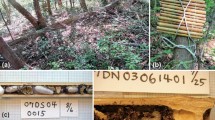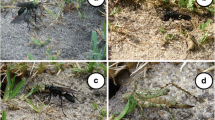Abstract
Anoplius eous Yasumatsu (Hymenoptera, Pompilidae) exhibits some outstanding nesting behavior. Females excavate a unicellular or multicellular nest in wet ground, or dig a single-celled nest in rotten wood, or build clustered mud cells in narrow spaces between walls of such substances as wood or vinyl sheets. The latter nest-type has been unknown within the subfamily Pompilinae. Females prepare a nest-cell before hunting, and construct it further after hunting, leaving the prey near the nest (behavior-formula: IVPTIOC). They transport their prey backward on the ground, grasping it in their mandibles by any part of the legs, and forward on the surface film of water or on the ground, grasping it by the middle part of the 1st or 2nd legs. Their only prey is the adult female semi-aquatic spider,Pardosa pseudoannulata (Lycosidae). These nesting and provisioning behavior patterns are compared with those of other pompilids. The position of the present species in the behavioral evolution of the Pompilidae is suggested.
Similar content being viewed by others
References
Day, M.C., 1981. A revision ofPompilus Fabricius (Hymenoptera: Pompilidae), with further nomenclatural and biological considerations.Bull. Br. Mus. Nat. Hist. (Ent.), 42: 1–42.
Endo, A., 1976. Factors influencing the prey selection of a spider wasp,Episyron arrogans (Smith) (Hymenoptera, Pompilidae).Physiol. Ecol. Japan, 17:335–350. (In Japanese with English summary.)
Evans, H.E., 1949. The strange habits ofAnoplius depressipes Banks: a mystery solved (Hymenoptera, Pompilidae).Proc. Ent. Soc. Wash., 51: 206–208.
Evans, H.E., 1962. The evolution of prey-carrying mechanisms in wasps.Evolution, 16: 468–483.
Evans, H.E., 1966. A revision of the Mexican and Central American spider wasps of the subfamily Pompilinae (Hymenoptera: Pompilidae).Mem. Amer. Ent. Soc., 20, ii + 442 pp., 11 pls.
Evams. H.E. & C.M. Yoshimoto, 1962. The ecology and nesting behavior of the Pompilidae (Hymenoptera) of the northeastern United States.Misc. Publ. Ent. Soc. Amer., 3: 65–119.
Evans, H.E. & R. W. Matthews, 1973. Dehavioural observations on some Australian spider wasps (Hymenoptera: Pompilidae).Trans. R. Ent. Soc. Lond. 125 (1): 45–55.
Gess, F.W. & S.K. Gess, 1974. An ethological study ofDichragenia pulchricoma (Arnold) (Hymenoptera: Pompilidae), a southern African spider-hunting wasp which builds a turreted, subterranean nest.Ann. Cape Prov. Mus. (Nat. Hist.), 9: 187–214.
Gess, F.W. & S.K. Gess, 1976. Ethological notes onDichragenia neavei (Kohl) (Hymenoptera: Pompilidae), an African spider-hunting wasp building a turreted, subterranean nest.Ann. Cape Prov. Mus. (Nat. Hist), 11: 129–134.
Hashimoto, S., 1941. Wasp carrying spiders on water.Trans. Kansai Ent. Soc., 11: 36. (In Japanese.)
Iwata, K., 1936. Biological notes onAnoplius, marginipennis Yasumatsu (Hymenoptera, Psammocharidae).Mushi, 9: 30–32.
Iwata, K., 1937. On the habits of sand-psammocharids from Japan.Kontyu 11: 238–259, 281–304. (In Japanese.)
Iwata, K., 1939. Habits of seven species of Pompilidae in Japan (Hymenoptera).Mushi, 12: 17–24.
Iwata, K., 1942. Comparative studies on the habits of solitary wasps.Tenthredo, 4: 1–146, pls. 1–5.
Iwata, K., 1971.Honno no Shinka: Hachi no Hikaku Shûseigakuteki Kenkyû. vi + 503 pp. Mano Shoten, Kanagawa. (In Japanese.) (1976.Evolution of Instinct. Comparative Ethology of Hymenoptera. ix + 535 pp. Amerind Publishing, New Delhi.)
Iwata, K., 1975.From the Field Notes of a Naturalist. 565 pp. The Asahi Shimbun, Tokyo. (In Japanese.)
Iwata, K., 1978a.Observations on Insect Life for 50 years, (I). 343 pp. The Asahi Shimbun, Tokyo. (In Japanese.)
Iwata, K., 1978b.Observations on Insect Life for 50 years, (II), 330 pp. The Asahi Shimbun, Tokyo. (In Japanese.)
Iwata, K., K. Kozima, M. Matsuura & K. Goukon, 1982. Japanese Wasp and Bee Life illustrated phylogenetically. 162 pp. Kodansha, Tokyo. (In Japanese.)
Kurczewski, F. E. & M. G. Spofford, 1985. Observations on the nesting and unique cachement behavior ofCalicurgus hyalinatus (Hymenoptera: Pompilidae).The Great Lakes Entomologist 18: 41–44.
Olberg, G., 1959. Das Verhalten der solitaren Wespen Mitteleuropas (Vespidae, Pompilidae, Sphecidae). 402 pp. Deutscher Verlag der Wissenschaften, Berlin.
Shimizu, A., 1989. An ethological study ofAgenioideus ishikawai (Hymenoptera, Pompilidae).Jpn. J. Ent., 57:654–662.
Tsuneki, K., 1946. The Japanese Hunting Wasps. Their Ecology and Psychology. viii + 254 pp., 5 pls. Hoppo Shuppansha, Sapporo, (In Japanese.)
Tsuneki, K., 1968. The biology of some Japanese spider wasps (Hymenoptera).Etizenia, 34: 1–37.
Wasbauer, M.S., 1957. A biological study ofAnoplius (Anoplius) imbellis Banks (Hymenoptera: Pompilidae).Wasmann J. Biol., 15: 81–97.
Williams, F.X., 1919. Philippine wasp studies.Bull. Exp. Sta. Hawaii. Sug. Plant. Ass., (Ent.), 14: 1–186.
Williams, F.X., 1928. Studies in tropical wasps — their hosts and associates.Bull. Exp. Sta. Hawaii. Sug. Plant. Ass., (Ent.), 19: 1–179.
Yasumatsu, K., 1936. Uber einige neue oder seltene Mordwespen aus Japan (Hymenoptera, Psammocharidae, Psammocharinae).Mushi, 9: 23–29, Tab. 4.
Author information
Authors and Affiliations
About this article
Cite this article
Shimizu, A. Nesting behavior of the semi-aquatic spider wasp,Anoplius eous, which transports its prey on the surface film of water (Hymenoptera, Pompilidae). J. Ethol. 10, 85–102 (1992). https://doi.org/10.1007/BF02350113
Received:
Accepted:
Issue Date:
DOI: https://doi.org/10.1007/BF02350113




